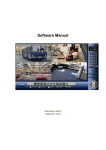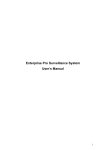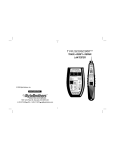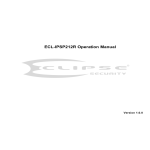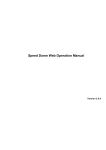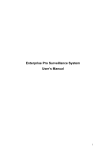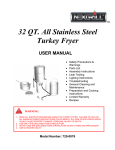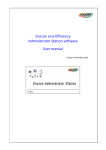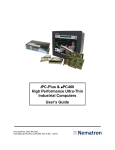Download DSS Operator User`s Manual _Base_ Version 2.2 201202
Transcript
DSS Operator User’s Manual (Base) Version 2.2 Table of Contents 1 GENERAL INTRODUCTION ........................................................................................1 1.1 Server .................................................................................................................................................................. 1 1.2 Client-end Feature............................................................................................................................................. 1 1.3 Environments ..................................................................................................................................................... 1 1.3.1 Hardware Requirement................................................................................................................................ 1 1.3.2 Software Requirement ................................................................................................................................. 1 2 OPERATION ................................................................................................................2 2.1 Log in................................................................................................................................................................... 2 2.2 Main Window...................................................................................................................................................... 2 2.3 Video window ..................................................................................................................................................... 3 2.4 Toolbar ................................................................................................................................................................ 5 2.4.1 Device Tree.................................................................................................................................................... 5 2.4.2 PTZ Control.................................................................................................................................................... 7 2.4.3 Window Split ................................................................................................................................................ 10 2.4.4 E-Map ........................................................................................................................................................... 11 2.4.5 Color Adjustment......................................................................................................................................... 12 2.4.6 Full Screen................................................................................................................................................... 13 2.5 Function Column.............................................................................................................................................. 13 2.5.1 Monitor Task & Monitor Project................................................................................................................. 13 2.5.2 Alarm............................................................................................................................................................. 18 2.5.3 Playback....................................................................................................................................................... 25 2.5.4 Additional...................................................................................................................................................... 31 2.5.5 Configuration ............................................................................................................................................... 34 2.5.6 CPU and Network Status Indication Light ............................................................................................... 39 2.5.7 Information Rolling Interface ..................................................................................................................... 39 i Welcome Thank you for using our software! ii 1 GENERAL INTRODUCTION In this chapter, you will find: Heading Content 1.1 Server DSS main features. 1.2 Client-end feature DSS hardware and software minimum requirement. 1.3 Environment Hardware and software requirement. 1.1 Server z z One transfer server: Max 150-channel D1 resolution one to one transfer capacity. One storage server: Max 150-channel D1 resolution one to one storage capacity. User management, organization management, device management, alarm information and system log. 1.2 Client-end Feature z z z z z z z z z z z z User mouse simulator to control PTZ easily E-map Audio talk function Monitor project customization function, multiple-window video touring, and four-channel playback simultaneously Local record central storage XML data storage Connecting to various devices at the same time and view video from multiple devices (realtime monitor and playback) Alarm activation configuration, view alarm prompt and record information. Local snapshot function Reserved intelligent analysis interface Support to update multiple devices at the same time Support various languages. 1.3 Environments 1.3.1 Hardware Requirement ① CPU Core 2 3.0 ② Memory 2G ③ HDD 10G free capacity ④ 1024*768 resolution displayer and display card 1.3.2 Software Requirement ①Microsoft Windows XP SP3 ②DirectX 9.0 or higher ③ Internet Explorer 7.0 1 2 Operation In this chapter, you will find: Heading Content 2.1 Log in DSS operator log in steps. 2.2 Main Window DSS operator main window introduction. 2.3 Video Window Video window introduction. 2.4 Toolbar It includes device tree, PTZ control, window split, emap, color adjustment, full screen. 2.5 Function Column It includes monitor task and project, alarm, playback, configuration, CPU and network status, information rolling interface. 2.1 Log in Double click the client icon in the desktop, system pops up the following interface. See Figure 2-1. Please input server IP, port (default value is 90000), user name and password to log in. For security reasons, please click button logged in. to modify the password after you first Figure 2-1 2.2 Main Window The video monitor interface is shown as in Figure 2-2. 2 ④ ① ② ③ Figure 2-2 There are four function sections: 1 Video window 2 Toolbar 3 Function column 4 Title column Video display and control Device tree, PTZ control, window split, E-Map, display color adjustment, full-screen and etc. Monitor project, alarm, playback, additioanl function, configuration and etc. There are CPU use percentage indication light, network card status indication light, message prompt section and log out button. Operation interface lock, zoom in, zoom out and exit. Client interface has two modes. The normal one is shown as in Figure 2-2. You can view video window, toolbar and function bar. In full screen mode, there is only video window, toolbar and function bar are hidden. Move your mouse to the corresponding position to view these two bars. Click to go to interface switch mode. 2.3 Video window In video window, right click mouse, you can see a shortcut menu is shown as in Figure 2-3. 3 Figure 2-3 Please refer to the following sheet for detail information. Please note, all the functions here are valid in specified conditions. Item Function Window:1 z Here you can view current window serial number. Close current window z Close current video window. Close camera z Close current camera (including the video you view in other window.) Close all windows z Close all video windows. Mouse simulator z Enable mouse simulator function. Save as task z Save current vide window and the corresponding camera as a task. Mode: Fluency z Switch between real-time mode and fluency. Audio z Enable or disable camera audio function. Local record Save the audio/video from current window to the client-end file. 4 Item Function Snapshot z Save the video from current window to the client-end (picture). Each time it saves one picture. z Here you can view device name, channel, capture date, operator name, picture size, capture time, capture reason and remarks. You can click the Save button to save it. z Audio talk z Enable/disable the bidirectional talk function of current monitor device. Matrix output z Save current mission or project to the matrix server to realize output to the wall. Save as Favorites z Save current channel to the Favorites folder. You can view the . It allows you to go to the current saved result in the channel quickly. 2.4 Toolbar 2.4.1 Device Tree Click device tree icon , you can go to device list interface. See Figure 2-4. There are three filters: organization, alarm output and Favorites. Organization Here you can view the front-end device and decoder according to the organization. For device node, it displays device name. Alarm Output Display alarm output information. For device node, it display alarm output channel. 5 Favorites You can save your interested channel in the Favorites folder so that you can view and manage them quickly. Right click the Favorites folder; you can add a new folder. You can also establish child-folder under current folder. Delete all button can remove all the cameras in the Favorites folder. Delete one item you can remove the selected camera. You can rename current folder and camera. You can drag the camera to one folder so that you can manage easily. Figure 2-4 Quick Search 6 System supports quick search by channel and by device. See Figure 2-5. z Search by channel: Input the channel name, you can quickly search all the channels include current keys, z Search by device: Input device name, you can quickly search all the devices include current keys. Figure 2-5 Note: In the main interface, please select a window you can see current window has a green edge. Double click one channel or drag the channel to the main window, you can view current channel video, that is to say, system is in real-time monitor mode. 2.4.2 PTZ Control Click PTZ control icon , you can go to the following interface. See Figure 2-6. The following button becomes grey and is not available, once current device has no PTZ function. (Or you have no right to operate PTZ function). 7 3D Positioning key PTZ lock key Mouse simulator key Click here to hide or display PTZ setup item. Figure 2-6 Item Function Direction key z There are eight directions: up/down/left/right, upper left, upper right, bottom left, and bottom right. z PTZ lock key z PTZ lock key allows you to control one speed dome exclusively among several DSS users. z The user of the same level can compete to control the dome right. z The user of higher right can take the dome control right from the user of the lower right. 8 Item Function 3D intelligent position z Click once in the monitor video, the PTZ can go to the selected point and display it in the middle of the screen. z Drag the mouse in the monitor video, the dragged section support 4x to 16x zoom. Drag the mouse from the top to the bottom, the video zoom in. Drag the mouse from the bottom to the top, the video zoom out. z Please use mouse to control. step z The value ranges from 1 to 8. zoom z Control dome to realize zoom in and zoom out. focus z Focus control Iris z Adjust dome iris. preset z Use direction key to adjust the dome to the specified position and then input preset value. Click save button to save current setup. Tour z Dome supports the auto touring function. Please note, this function does not need the dome to support. As long as the speed supports preset function, it can realize touring. The touring function disabled if the client window is cancelled. Aux z Light, wiper, PTZ menu, auto flip, aux1 and aux2. Preset Click the set button of the preset, system pops up a dialogue box. See Figure 2-7. Use the direction keys to turn the PTZ to the specified position, and then you can input serial number and name in the preset dialogue box. Click set button to save current preset setup. Repeat the above steps to set more presets. Figure 2-7 Tour Click the set button of the tour, system pops up the following dialogue box. See Figure 2-8. In Figure 2-8, click new button, you can see an interface is shown as in .Figure 2-8. Please input tour serial number and name. Select the preset from the dropdown list and then input interval value. Please click add button. 9 Repeat above steps to add more presets into the tour. Click ok button to save current tour setup. Figure 2-8 Figure 2-9 2.4.3 Window Split Click window split button , you can see an interface is shown as in Figure 2-10. Please select your desired window amount from the list. 10 Figure 2-10 2.4.4 E-Map Click e-map button , you can go to the following interface. See Figure 2-11. Click here to display e-map device tree. Figure 2-11 You can see there is a zoom bar. See Figure 2-12. E-map support e-map zoom and position adjustment (move to left, move to right or in the middle.) 11 Figure 2-12 The on the left corner supports e-map go forward or backward, or go to the firs E- map. E-map device tree menu is shown as below. See Figure 2-13. Figure 2-13 E-map abbreviation image is shown as below. See Figure 2-14. E-map abbreviation image Figure 2-14 2.4.5 Color Adjustment 12 Click color adjustment control button , you can go to the following interface. See Figure 2- 15. Here you can adjust brightness contrast, hue and saturation. You can click default value button to go back to default setup. Figure 2-15 2.4.6 Full Screen Click full screen button , you can go to the full screen or exit full screen. 2.5 Function Column At the bottom of the function column, click the monitor project button and then select the configuration button. See Figure 2-16. Figure 2-16 2.5.1 Monitor Task & Monitor Project Monitor Task Monitor task allows you to select the camera displayed in corresponding window, and then set the touring strategy. Monitor project is to set schedule time so that system can auto switch monitor task correspondingly. One monitor project consists of several monitor tasks. Click monitor project button and then select configuration item, you can see an interface is shown as in Figure 2-17. 13 Figure 2-17 Monitor project interface is shown as below. See Figure 2-18. Figure 2-18 In Figure 2-17, click new button, you can see the following interface. See Figure 2-19. Please input task name and select window amount from the dropdown list. Then please open the device tree and drag corresponding channel to the column. Now you can input stay time and preset value. Please click add button. You have established one task. You can select the main stream and extra stream from the dropdown list if the device has enabled the extra stream function. Finally, you can click O.K button to save the tasks. 14 Step1: Input task name and then select window amount here. Step 2: Select a window option here. There are two types of options: All windows and the respective window. You can set for all windows at the same time or set for each window one by one. Step 4: Select stream type here: main stream/extra stream. Step 3: Select a channel here and then drag it to the column and then release. Figure 2-19 Important! Please note the stay time is the displayed video period in specified camera. Please refer to chapter 2.4.2 PTZ Control for camera preset information. The preset value ranges from 0 to 255. If you want to use preset function, please make sure current camera has preset setup, otherwise this function is null. You can click delete button to remove the sub-item from the task. Click OK button, you can see there are newly added tasks. See Figure 2-20. Click up down button you can select the different items in the same window. Figure 2-20 When the window amount you selected is more than 1, there are two ways for you to add the channel into different windows. 15 Select all windows If you selected All Windows to add channel you can drag the channel from the tree menu to the task. If there is item in the list, the window serial number is the same as before. If you drag channel to the bottom of the list, that is to say, the listed window serial number is smaller than the selected window amount, then system adds one window number. If listed window number is the same as the selected window amount, the newly added window serial number is the same, just as the selected amount. In Figure 2-21, you can see there is a task of four windows. You have added three channels to three windows respectively. Figure 2-21 If you drag the channel 8 to the Line 3, then you can see the newly added channel 8 is in window 3. See Figure 2-22. Figure 2-22 16 In Figure 2-21, if you drag the channel 8 to the Line 4, you can see the newly added channel is in window 4. See Figure 2-23. Figure 2-23 Add to specified window If you select respective window to add channel, you can just drag the channel to the corresponding window. Monitor Project In Figure 2-18, click new button, system pops up the following interface. See Figure 2-24. Please input project name and then select task (mission) name from the dropdown list. Please select the start time and then click add button; you have added one task into the monitor project. Figure 2-24 Repeat the above steps to add more tasks into current monitor project. See Figure 2-25. 17 Figure 2-25 In Figure 2-25, you can select one project and then click modify button to modify a project. The modification interface is similar to Figure 2-24. In Figure 2-25, you can double click one task name to modify the setup. Please click update button to save the modification. Please note update button is null in default mode. Enable and Disable Before you enable a task or project, please make sure you have properly set alarm input and alarm output (buzzer, light and etc). Click monitor project button at the bottom of the main interface ( ), you can see the following interface. See Figure 2-26. Here you can enable/pause the monitor project. In Figure 2-26, you can see project Door is running now. If you want to stop Door, you need to click pause button first (Pause button becomes Resume button) and then click Door again to disable. Figure 2-26 2.5.2 Alarm Before enable alarm setup, please make sure you have properly connected the alarm output device (light, buzzer and etc.). Please make sure the alarm function of the device is valid now. Please refer to the corresponding front-end device (such as DVR, IPC) user’s manual for detailed information. For example, the DVR alarm setup interface is shown as in Figure 2-27. 18 Figure 2-27 Click alarm button , you can see an interface is shown as in Figure 2-28. There are max six periods in one day. For one alarm scheme, if the first time period is from 8:00 to 12: 00, and the second time period is from 9:00 to 12:00, system only implement the first alarm scheme. Figure 2-28 In Figure 2-28, click add button to add one alarm scheme. See Figure 2-29. Global Configuration For global configuration, you can enable prompt sound when alarm occurs and allow the system to pop up the dialogue box in the alarm message window. z Other options: Alarm scheme name: Input current alarm scheme name so that system can display it in the scheme period setup interface. Cursor stays in the information window for ___seconds becomes “read”: The message becomes “read” status if the cursor stays for specified time. 19 Automatically overwrite the previous alarm: If you enabled this function, system automatically overwrites the previous alarm when new alarm occurred. Play sound repeatedly: System repeat the alarm sound if you enabled this function. Automatically select a window for alarm link video: If you enabled this function, system automatically select a window to display video when there is an alarm activating the video. Alarm is always flashing in the E-map: The alarm icon always flashes when an alarm occurs if you can check the box here. z Prompt sound Please note you can select different sound for various alarms (motion detect, video loss, external alarm, camera masking). The sound default setup is null. System uses program default alarm sound. The alarm sound is saved in the Sound folder of your installation directory. You can check the box to select all prompt sound. z Show alarm message You can view the alarm information in the information rolling interface if you check the corresponding alarm type here. You can view all the alarm information in the information rolling interface if you check the all here. box z Alarm video matrix Check the box and then click the detailed setting button; you can see a following interface. See Figure 2-30. Here you can select alarm video amount 1/4/9-window. You can select the matrix output channel and then save. Figure 2-29 20 Figure 2-30 Arm & disarm Arm and disarm interface is shown as in Figure 2-31. It includes four types. You can select the device first and then select corresponding alarm type for specified channel. If you check the box in front of the device name, all of its channels will be armed. z Motion detection: After analysis the video, system enables motion detection alarm once the system detects the motion signal reach the specified sensitivity z Video loss z Camera masking: When someone is viciously masking the camera, system can alarm so that you can still monitor current video. z External alarm 21 Figure 2-31 Activation Strategy Activation strategy interface is shown as in Figure 2-32. In the alarm device, select the channel and then select the type, prompt sound and set to display alarm information in the information rolling interface or not. Click Modify button here. Figure 2-32 Click the modify button of current activated video, system pops up a dialogue box. See Figure 233. You can select from the channel, then set activation video window, preset, stay time. Click >> to add the corresponding information to the activated video list. You can repeat the above steps to add more activation video. 22 Figure 2-33 Click OK button to complete activation video operation, system goes back to the activation strategy interface. Click the modify button of the existed operation, system pops up the dialogue box. The interface is similar to the Figure 2-34. Click OK button, you can save the modification. Figure 2-34 After your set alarm activation strategy, please click alarm button to set the period. See Figure 235. 23 Figure 2-35 If an alarm occurs in the specified period, you can see the following interface. See Figure 2-36. Please refer to the following sheet for detail information. 1 Alarm video window: when alarm occurs, the activated channel video will be displayed here. 2 Alarm output list, when alarm occurs, the activated alarm output is displayed here. 3 Here you can view the pending alarm amount. When there are alarm to be processed, click next button you can view corresponding alarm name and the activated video name. ② ① ③ Figure 2-36 Please refer to the following sheet for detailed information. 24 Button Note Open/Close z Right click alarm output list you can see there are two options: open or close alarm output. z The button is for Base version only. z Select alarm video window and begin audio talk with the device end. z The button is for Base version only. Window split z Click window split item, you can see there are three options: 1/4/9 window. See Figure 2-33. Next z Click it to process the next alarm. Exit z Exit current alarm video interface. Audio talk Figure 2-37 2.5.3 Playback Click playback icon , you can see an interface is shown as in Figure 2-38. Here you can search, playback, download the monitor records and search alarm information. It includes four function buttons. z Record (Record search): Here you can search playback or download all kinds of record file from the platform or the device-end. z Alarm (Alarm search): Here you can search the alarm information of the camera or the alarm device according to all kinds of alarm types. z Local (Local playback): Here you can search and playback records from client-end, or the record files you download from the platform or device and save in the default path. z Mark (Mark search): Here you can search the marked record file according to the mark information. 25 ① ④ ⑧ ⑤ ② ⑦ ⑥ ③ Figure 2-38 Please select the camera ID and type first and then input corresponding search condition. Click corresponding date in the calendar, you can view the search result on your right side. See Figure 2-39. ⑨ ⑩ Figure 2-39 26 Please refer to the following sheet for detail information. 1 Device tree You can select a channel from the device tree to begin record search or alarm search 2 Multiple playback You can draw a circle to enable multiple-channel list playback mode. Then double click channel number to add it to the list. (Max 4 channels.) 3 Calendar You can click the date in the calendar to begin record search. 4 Playback window Record display window. 5 Playback control The button from the left to the right are: Pause, bar play, stop, fast play, slow play, record, snapshot, previous frame, next frame, local file, mute and volume bar. 6 Time control bar The time indicator can locate record play time. Click or double click the time control device to begin play. Please note, if the start time is earlier than current play time, please double click to begin play. 7 Record type There are five record types: General record, external alarm, motion detection, video loss and camera masking. 8 Mark Mark the information on the corresponding time of record. 9 Download list Here you can view download list. 10 Playback process bar Playback process bar in file playback mode. Mark Search You can search the record file according to the previously set mark in the file. Click button , you can view the following interface. See Figure 2-40. Figure 2-40 Please input mark name, mark contents, note and etc. Click Save button, you can see an interface is shown as below. See Figure 2-41. 27 Figure 2-41 During the playback process, you can search the mark. There are two ways. The first way is you can input the mark name in the column and then click the button . You can view the searched results (The file of the mark you specified) in the following interface. See Figure 2-42. Figure 2-42 The second way is you lick the button to set the search criteria manually. See Figure 2-43. Please select organization, device name, channel name. You can check the record time and then set start/stop time, system can begin by record time. If you check the mark time and then set start/stop time, system can begin search by mark time. Figure 2-43 In Figure 2-43, select one searched file and then right click the mouse, you can see the following interface. See Figure 2-44. Here you can play the file, view mark detail information, delete mark and etc. You can check one of the following three items to set the default operation 28 of the double click. Double click to play, double click to open the mark, and double click to remove the mark. Figure 2-44 Please refer to the following sheet for detailed information. Button Note Multiplechannel playback z You can click this button to enable multiple-channel playback. System maximally supports 4 channels. Time download z You can search record from the device-end. Record list button z Click it, system pops up record list dialogue box, you can view the searched results. Download list/record playback z Click it, system switches between download list interface and record playback interface. Download path z Click it to open download record path. Switch button z Click it to switch between time control bar and playback process bar. Record Search Operation Please follow the steps listed below. z One-channel search: Please select a channel from the device search tree. z Multiple-channel search: Please draw a circle to enable multiple-channel search function and then double click the channel to the multiple-channel playback list. System max supports 4 channels. z Select search type; device or platform. If you have selected the direct connected device, then the device/platform button is null. z Click date in the calendar to begin search. z The searched result is displayed in the time control bar/ Click file list button, the corresponding recorded files is also displayed in the record list. See Figure 2-45. z Click the corresponding time at the time control bar to begin playback. You can click different time to begin playback and drag the time indicator to locate playback time. Or you can click one or more items in the record list to begin playback or download operation. If you want to 29 playback, then the record is controlled by the playback process bar. You can click process bar to begin playback again or drag the process bar to locate record play begin time. Figure 2-45 Alarm Search Operation Please follow the steps listed below. z Select channel from the device tree. z Select alarm type and start/end time. z Click date in the calendar to begin search. z Now you can see system pops up the following interface. See Figure 2-46. Here you can select one alarm record and click the play or download button to play the video or download to your local PC. You can select several record to play at multiple-window. You can see system pops up a dialogue box says there is no record if there is no activation record. Figure 2-46 30 Record Download Operation System supports two download modes: time and file. Download by time: Please select the channel first, and then click Timedownload button, system pops up the following dialogue box. See Figure 2-47. Select start time and end time, then click OK button, you can begin search operation. Figure 2-47 Download by file: Please select the channel and then click the date in the calendar. System pops up the following dialogue box. See Figure 2-48. You can select the corresponding file to download. Figure 2-48 Note: System max supports 4-ch playback. Search type includes two options: Device search and platform search. The searched result displayed in two modes: Time and file. It displays the searched result in the time control bar. It displays the different record files in different colors. Click record list button, you can view the search result in the record list. Please note, when there are several record types in the same period, the select all button in the time control bar may displayed in a different color. It results from the overlay. 2.5.4 Additional 31 Click the additional button , it includes three items: local picture search, audio talk/broadcast and video wall controller manager. Local picture search The local picture search interface is shown as in Figure 2-49. z You can select the search conditions here (organization/device/channel) first. z Select the start time and end time and then click the button to search the results. z Now you can view the search results at the right bottom of the pane. z Click the image name to view the image information. Right click the mouse you can save the image to your local-end. In the first step, system can only search in the current list to search the image. If you check the box . If you do not check the box here, system can search the snapshot image of the device that even removed. The picture may come from two sources: snapshot during the real-time monitor process/snapshot during the record playback process. You can add the memory information during the snapshot. Step 1: Select organization/devic e/channel here. Step 2:Select time here. Step 3:Click query button here. Step 4:View search results here. Figure 2-49 Audio talk/broadcast The audio talk/broadcast interface is shown as in Figure 2-51. This function allows you to talk to the front-end device and realize the broadcast. You can select a device on the left pane and then click the bidirectional talk. z Sampling: 8K-8bits,8K-16bits,16K-16bits. 32 button to realize the z z z Audio format: default, PCM, G711a, G711u, AMR, G726, G722. Delete: it is to remove one group from the broadcast list. Clear: It is to remove all groups from the broadcast list. The audio talk/broadcast audio are saved in the Local setup->Path setup See Figure 2-50. Figure 2-50 Select a device here. Click here to begin bidirectional talk Figure 2-51 Broadcast The broadcast interface is shown as in Figure 2-52. Please select several devices on the left pane and then click the current devices as a group. Now you can see the newly added group on the right pane. See Figure 2-52. Please click the z button to begin the broadcast. Delete: It is to delete selected group from the broadcast list. 33 button to save z Clear: It is to clear all the groups from the broadcast list. Figure 2-52 Video Wall Controller Management Click it you can go to the video wall controller interface to realize the video wall operation. Please refer to the video wall controller user’s manual for detailed information. 2.5.5 Configuration Click configuration button, you can see an interface is shown as in Figure 2-53. Figure 2-53 Language You can select corresponding language from the dropdown list. Local setup In the following interfaces, there are five function buttons. z Up: Click it to move to the up item to set. z Down: Click it to move to the next item to set. z Restore: Click it, system restores factory default setup. z Save: Click it to save current setup. z Cancel: Click it to exit current interface and do not save current setup. Start Parameter The local setup interface is shown as in Figure 2-54. 34 z z z z z z Start window: Here you can select the system start window amount when the system boots up. Resume previous monitor project: If you check the box here, the system can resume the previous running monitor project when DSS boots up the next time. Minimize after boots up: If you check the box here, the system automatically minimizes the client-end after it boots up the next time. Auto run when PC boots up: If you check the box, the system starts automatically when the operating system boots up the next time. Hide the trees of no devices (The setup becomes activated after reboot.) If you check the box here, system will not display the tree node without the device. Auto synchronization time: Check the box here, PC of the DSS operator can synchronize time with the DSS server. Figure 2-54 Media transport The media transport interface is shown as in Figure 2-55. z Protocol: There are three options: auto/UDP (default)/TCP. Figure 2-55 Stream type 35 The stream type is shown as in Figure 2-56. and the Please note the can not be valid at the same time! z Bit stream type: You can select main stream or extra stream from the dropdown list. Please note, you need to go to Manager Client-end->Add device interface to enable the extra stream function. z Auto select stream type by window size: If you check the box here, system will select the stream type automatically according to the window size. Please note the system will use the extra stream to open the video if current window amount is more than 25. z Use default stream type: There are two options: main stream/extra stream. You need to check the box to enable current function. Please note you need to go to the Manager Clientend->Operation Setup->Device Management->Add Encoder to enable the extra stream function, if you want to use the extra stream as the default type. Figure 2-56 Path setup The path setup interface is shown as in Figure 2-57. z Record: You can click the browse button here to set the record file saved path. z Picture: You can click the browse button here to set the picture file saved path. 36 Figure 2-57 Direct connection parameter The direction connection parameter is shown as in Figure 2-58. z Monitor and playback file in the direct connected device (The setup becomes activated after reboot.). If you enabled this function, then the system directly connected to the device when it is in real-time mode and playback mode. Figure 2-58 Audio parameter If you check the box here, the DSS can automatically select the corresponding format when the bidirectional talk function is on. Once you cancel the box there, you can select this item manually when you are using the bidirectional talk function. 37 Figure 2-59 Other parameter The other parameter interface is shown as in Figure 2-60. z PTZ timeout: This setup is for PTZ lock function. If you have enabled the PTZ lock function, you can set the lock period here. The PTZ will unlock after the specified time you input here so that the user of the lower right can use the PTZ. z Picture type: There are two options: JPG/BMP. Figure 2-60 Modify Password Click modify password, you can see the following interface. See Figure 2-61. Please input current password and then input new password to confirm. 38 Figure 2-61 Exit Click exit button, you can see the following interface. See Figure 2-62. Please click Yes button to exit or click No to go back to system. Figure 2-62 2.5.6 CPU and Network Status Indication Light The CPU and network card status indication light is shown as in Figure 2-63. There are three indication lights: z Red: The occupation rate is over 66%. z Yellow: The occupation rate ranges from 33% to 66%. z Green: The occupation rate is below 33%. Figure 2-63 2.5.7 Information Rolling Interface There is an information rolling interface for you to view current device status. See Figure 2-64. Figure 2-64 Click the rolling interface; you can see an interface shown as in Figure 2-65. Here you can view motion detection, external alarm, video loss or other alarm and system information. 39 Figure 2-65 Right click an alarm record (such as alarm record 3); you can see an interface is shown as in Figure 2-66. Please note this function does not apply to upper version. Figure 2-66 Select alarm confirm button or double click the alarm record, you can see the following interface. See Figure 2-67. 40 Figure 2-67 You can select several alarms to confirm at the same time. See Figure 2-68. Here you are going to confirm alarm record 1 to alarm record 2. Figure 2-68 Click alarm confirm button, you can see the following interface. See Figure 2-69. You can select the suggestions from the options on the right. Or you can input your idea directly. Figure 2-69 Note z This user’s manual is for reference only. Slight difference may be found in user interface. z All the designs and software here are subject to change without prior written notice. z If there is any uncertainty or controversy, please refer to the final explanation of ours. z Please visit our website for more information. 41

















































